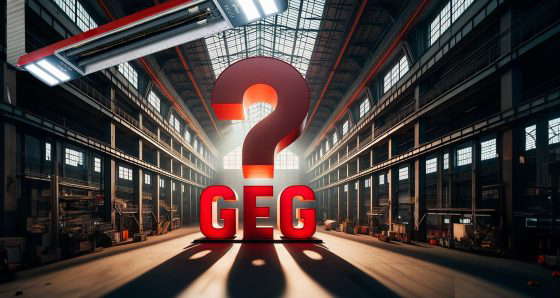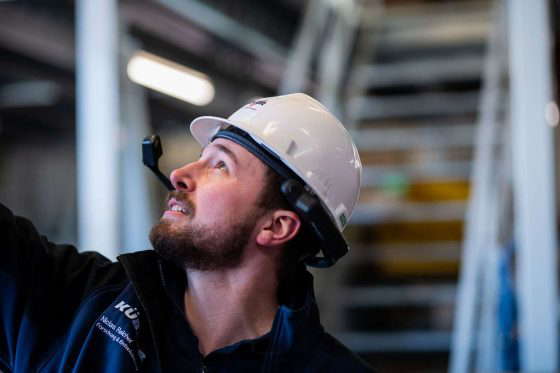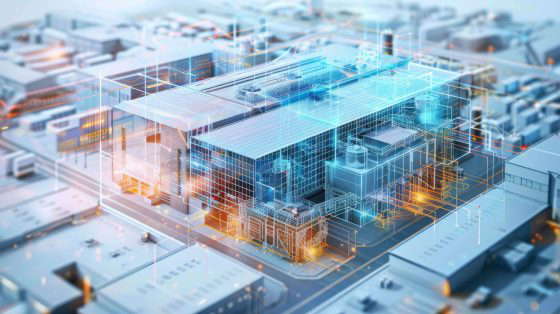On the way to climate neutrality - what you should know about the hall heating of the future

Stopping climate change - how climate-neutral heating is the first step in the right direction
Hardly anyone doubts that something has to happen to get man-made climate change under control. The ambitious goal in the amended Climate Protection Act is therefore: Germany wants to achieve climate neutrality not by 2050, but by 2045. This means that all greenhouse gas (GHG) emissions from electricity generation and industry to buildings, transport and agriculture are to be reduced as much as possible. Unavoidable emissions are to be offset by greenhouse gas sinks. In order to achieve this, the Climate Protection Act sets a concrete interim target for GHG emission reductions by 2030, namely by at least 65 % compared to 1990. The target is therefore clear. It is also clear that an important step here is to switch to climate-neutral heating with hydrogen or other alternatives in the long term.
Finally more clarity on the path to climate neutrality
The path to climate neutrality raises a lot of questions and causes a great deal of uncertainty. Especially for those who have to make decisions about investments that reach far into the future. One example of such investments are industrially used Hall heating systems with a life cycle of 15 years or more. Anyone considering such a purchase today should definitely look into heating systems that provide climate-neutral heating. But what exactly is behind climate-neutral heating and the goal of climate neutrality?
The report published on October 11, 2021 by the Kopernikus project Ariadne1) could provide clarity here. This is a study by more than 50 researchers from 10 institutes who have examined and evaluated various transformation scenarios for climate neutrality. This is the first comprehensive and detailed model comparison with robust findings on transformation paths, scope and bottlenecks. The following key insights can be derived across all scenarios and models:
- The central energy sources in a climate-neutral energy system are mainly renewable electricity, green hydrogen and green e-fuels as well as sustainably produced biomass.
- An increasingly renewable electricity supply is the main pillar of the further decarbonization of the energy system.
- In the target scenarios, the increase in energy efficiency alone will lead to a reduction in final energy consumption of 34 - 59 % by 2045 compared to 2019.
And it is also clear, according to the last point: the climate protection targets for 2030 and 2045 are extremely challenging and can only be achieved with massive investment, additional political measures and infrastructure development in all sectors.
1) Source: Germany on the road to climate neutrality in 2045: Scenarios and pathways in a model comparison. https://ariadneprojekt.de/publikation/deutschland-auf-dem-weg-zur-klimaneutralitat-2045-szenarienreport/
The most important facts about climate-neutral heating from the coalition agreement of the traffic light coalition
The coalition agreement of the traffic light coalition entitled "Daring more progress" has now been on the table for a short time. Despite a constructive spirit for the future, it still contains a lot of uncertainties, according to the DIHK in its first preliminary overall assessment2). Nevertheless, it is now becoming clearer how the path to climate neutrality can be shaped. The key statements in the coalition agreement are particularly relevant for investments in energy-intensive technologies such as hall heating systems. We have summarized them for you with reference to page and paragraph of the coalition agreement:
P. 27 - Chapter "Economy" Keyword "Industry"
- We are committed to the establishment of a European Union for green hydrogen.
- To this end, we want to provide financial support for investments in the development of a hydrogen network infrastructure.
- We want to become the lead market for hydrogen technologies by 2030.
- für eine Initiative zur Gründung eines für alle Staaten offenen internationalen Klimaclubs mit einem einheitlichen CO₂-Mindestpreis und einem gemeinsamen CO₂-Grenzausgleich.
p. 59f - Chapter "Climate, energy, transformation" Keyword: "Gas and hydrogen"
- An energy infrastructure for renewable electricity and hydrogen is a prerequisite for Europe's ability to act and remain competitive in the 21st century.
- We are accelerating the massive expansion of renewable energies and the construction of modern gas-fired power plants in order to meet the rising demand for electricity and energy over the coming years at competitive prices.
- Die bis zur Versorgungssicherheit durch Erneuerbare Energien notwendigen Gaskraftwerke müssen so gebaut werden, dass sie auf klimaneutrale Gase (H₂-ready) umgestellt werden können.
- Natural gas is indispensable for a transitional period.
- We want to drive forward the development of an efficient hydrogen economy and the necessary import and transport infrastructure as quickly as possible.
p. 60 - Chapter "Climate, energy, transformation" Keyword: "Grids"
- Electricity and hydrogen grids are the backbone of the energy system of the future
P. 90 - Chapter "Building and housing" Keyword: "Climate protection in the building sector"
- amend the Building Energy Act (GEG) as follows: By January 1, 2025, every newly installed heating system is to be operated on the basis of 65 percent renewable energy3).
- In the GEG, the new construction standards will be aligned with KfW-EH 40 as of January 1, 2025.
- In addition, measures equivalent to the GHG emission reduction target can be used under the innovation clause.
- We focus on tailor-made and technology-agnostic measures
We will continue to develop and restructure the funding programs in line with the objectives and requirements.
Coalition agreement in the federal government 2021. First, preliminary overall assessment © Deutscher Industrie- und Handelskammertag e.V. (DIHK) | Berlin | Brussels, as at: November 2021
Decentrally heated halls (zones) with room heights > 4 m are exempt from the obligation to use renewable energies to cover heating and cooling energy requirements (GEG).
In summary, for climate-neutral heating this means that...
... green electricity and green gas (hydrogen) are the energy sources on the road to climate neutrality. The importance of natural gas as a bridging technology is confirmed - the fossil fuel with the lowest carbon footprint will continue to be used as a transitional solution until we can heat completely climate-neutrally with hydrogen. And this is also emphasized: In addition to renewable energies, equivalent measures that follow the goal of reducing GHG emissions, such as increasing energy efficiency, are recognized, which benefits our decentralized gas-powered hall heating systems and makes them an option for climate-neutral heating
Highly efficient and flexible: decentralized gas-powered hall heating systems flank the path to climate-neutral heating
Diese Aussagen geben Klarheit darüber, dass erdgasbetriebene dezentrale Infrarot-Hallenheizungen auf längere Sicht der Golden-Standard in der Hallenbeheizung bleiben werden. Dafür gibt es gute Gründe, denn die speziell für die bauphysikalischen Bedingungen von Hallengebäuden entwickelten Heizungssysteme sind bei Raumhöhen > 4 m in puncto Energieeffizienz und Wirtschaftlichkeit den meisten technischen Alternativen deutlich überlegen. Aufgrund ihrer hohen Energieausbeute und sehr geringen peripheren Verlusten realisieren Infrarotheizungs-Technologien Typ Dunkelstrahler wie die von KÜBLER Energieeinsparungen zwischen 30 und 70 Prozent. Sie können bereits heute die Anforderungen der Klimaziele von 2030 erfüllen – es handelt sich hier also nicht um vollkommen klimaneutrales Heizen, ist aber im Vergleich zu den Alternativen wesentlich umweltfreundlicher, da die Energieeffizienz besonders hoch ist. Hinzu kommen die relativ geringen Investitionskosten. Und übrigens lassen sich die Highefficiency-Technologien des Ludwigshafener Hallenheizungsspezialisten bereits heute mit Biogas4) betreiben und sind H₂-ready. Das bedeutet: sobald Ihnen Wasserstoff zur Verfügung steht, können Sie diesen mit einem zuverlässigen Anteil von 20 Vol.-% (und zunehmend mehr) problemlos beimischen, sodass man sich Schritt für Schritt dem klimaneutralen Heizen nähert.
Hall heaters of the dark radiator type also impress with their flexibility when it comes to Heating of production, storage and other hall buildings. The decentralized gas-powered solutions have extremely short heat-up and switch-off times compared to hot water-based technologies. This means that your hall heating system can react immediately to additional shifts or changes in the outside temperature - so you don't have to chase yesterday's weather, which is also the right step towards climate-neutral heating. Because the appliances only require a small amount of space under the ceiling, there is plenty of room for them to be used. And unlike with underfloor heating, your hall floor also gives you full flexibility, e.g. for changes to the machine layout.
Climate-neutral heating with KÜBLER - what the hall heating of the future looks like
The energy sources of the future are renewable electricity and green hydrogen. What does this mean for climate-neutral heating in industry? KÜBLER, the innovation leader for energy-saving hall heating systems, sees two main options here:
- Due to its high efficiency and the still volatile availability of renewable energy sources, the hall heating of the future will continue to be based on natural gas or liquid gas in the long term.
- An increasing proportion of green gases will be added to fossil gases - until the technical challenges of producing and distributing hydrogen are solved and the systems are operated 100 % with hydrogen.
When exactly this will be remains to be seen. What is clear, however, is that both industry and the private sector will have to switch to climate-neutral heating with green hydrogen in order to achieve complete climate neutrality. Until then, we will have to rely on heating systems with high energy efficiency and gradually prepare the fossil gases used for this purpose until we can switch completely to the use of hydrogen.
-
The decision on the Heating Act (Building Energy Act - GEG) has been made, but the questions remain. But there is no need to worry: the legislator has provided for generous transition periods, technological openness and pragmatic, affordable regulations for the gradual move towards climate-neutral heating by 2045. Dr. Jens Findeisen explains what you need to know now when heating commercial and industrial buildings
-
Nobody thinks about the hall heating when the sun is blazing, the asphalt is glowing and everyone is grateful for the slightest cooling. Or do they? Because anyone who looks ahead knows that summertime is maintenance time. So if you want to start the winter safely with your production halls or warehouses, it's good to be prepared. After all, the next heating period is often around the corner sooner than you think, which raises the question: is your hall heating system fit for the next season?
-
Fair.AIdH - ideal heating systems for special buildings Halls have different heating requirements than office or other multi-storey buildings. As a rule, "normal" hot water heating systems inevitably fail due to the enormous room heights and dimensions: they consume an unreasonable amount of energy, offer little flexibility and thermal comfort, can hardly be controlled variably, heat hall ceilings instead of work areas, are often simply uneconomical and [...]
-
ESG stands for Environmental, Social and Corporate Governance and refers to the three key areas of sustainable corporate management: environment, social affairs and corporate governance. But what does this have to do with you and the way you heat your production halls and warehouses?





